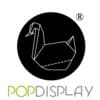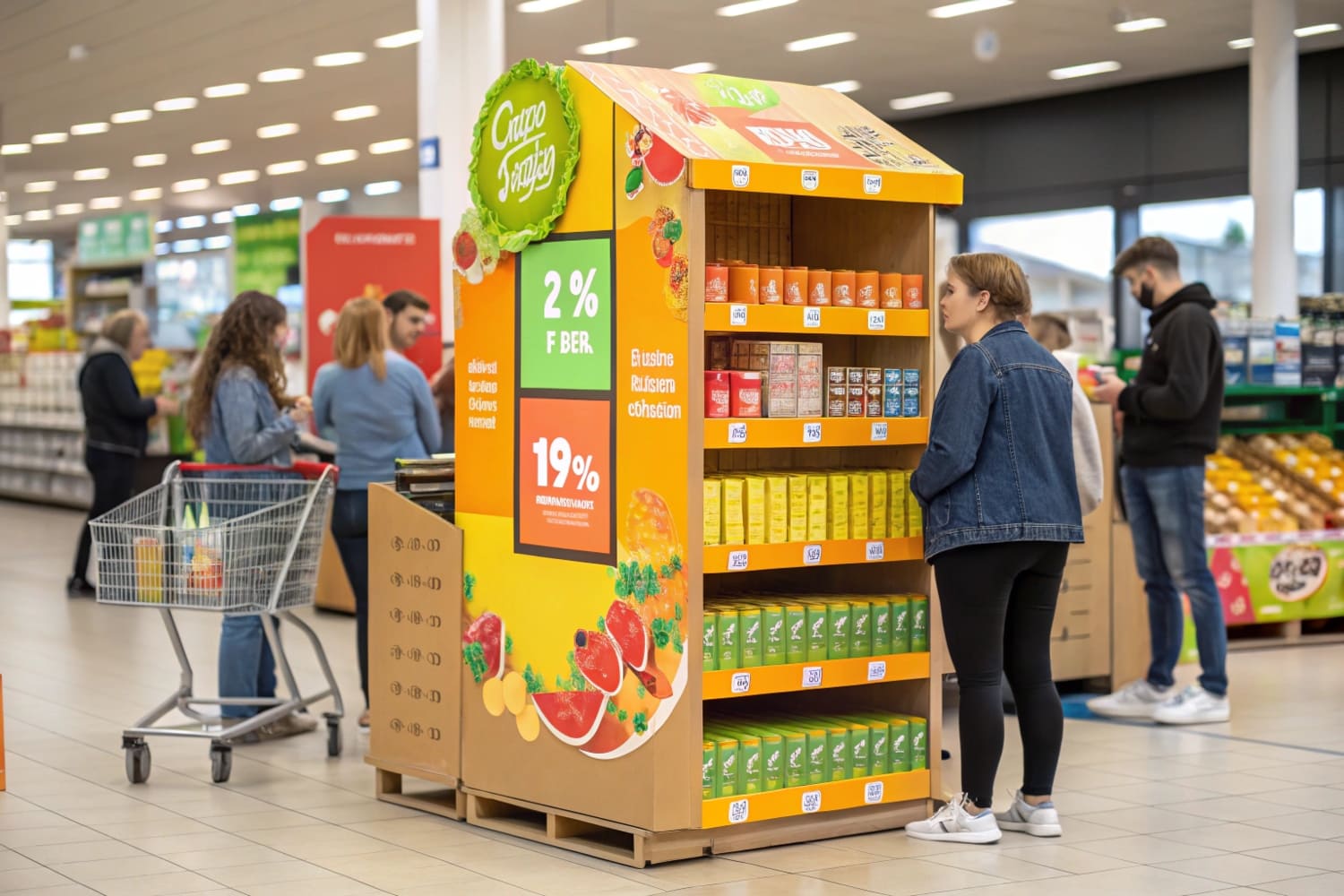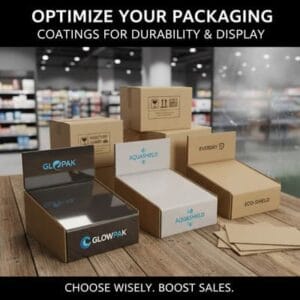Shoppers face too many choices. Promotions get lost. I use POP displays to stop the scroll in real life, guide a quick choice, and turn interest into action fast.
A POP display exists to grab attention at the shelf, explain the offer in seconds, reduce choice friction, and convert impulse into sales; it does this through clear structure, bold graphics, smart placement, and fast setup.

I will keep this simple and useful. I will show how purpose links to design, timing, and budget. I will also share a short story from my factory floor when it helps. If you want a quick answer, take the bold lines. If you want proof and steps, read the deeper parts.
What is the purpose of a pop screen?
Shoppers skim. Static prints fade in busy aisles. I use POP screens to add motion, show use, and deliver short messages that answer real buying questions fast.
A POP screen brings motion and sound to the aisle, demos the product in seconds, rotates offers by time or stock, and boosts dwell time so more people understand and choose.

When a screen beats print
A screen earns its spot when a static panel cannot teach the use case quickly. Motion shows "how it works." Short clips answer "will this fit me?" or "is there a bundle?" I trigger day-part content1 for morning, lunch, and evening traffic. I push price or bundle updates without reprinting. My team keeps clips under ten seconds because long videos lose shoppers. I add captions because stores are loud.
How I plan content
I start with three moments: hook, proof, and action. The hook is one moving benefit shot2. The proof is a short demo or social review. The action is a clear price or QR code. I design the surround in corrugated board to frame the screen and hide cables. I use flat-pack parts3 to ship small and assemble fast.
Simple ROI map
| Goal | Why a Screen Helps | Typical KPI | My Checklist |
|---|---|---|---|
| Explain use quickly | Motion shows steps in 5–10 seconds | Dwell time, recall | 10s loop, captions, one CTA |
| Reduce returns4 | Fit/how-to clips prevent mismatch | Return rate | Show sizing, show install |
| Update offers | Remote content switch | Promo compliance | Wi-Fi/USB plan, content calendar |
| Lift conversion5 | Proof + price next to product | Conversion, UPT | Test two edits, track sell-through |
In one seasonal launch, a 7-inch screen6 on a floor unit lifted conversion by double digits7 in week one. Print only did not. I kept the rest of the structure cardboard to control cost and speed.
What is the purpose of a pop it?
Stress is real in stores and schools. Many people fidget. I see Pop It toys at checkout because they promise calm, focus, and a small reward for kids and adults.
A Pop It is a tactile fidget toy that helps people self-regulate, reduce stress, and focus; in retail it works as a low-price impulse item that converts near checkout and kid-traffic zones.
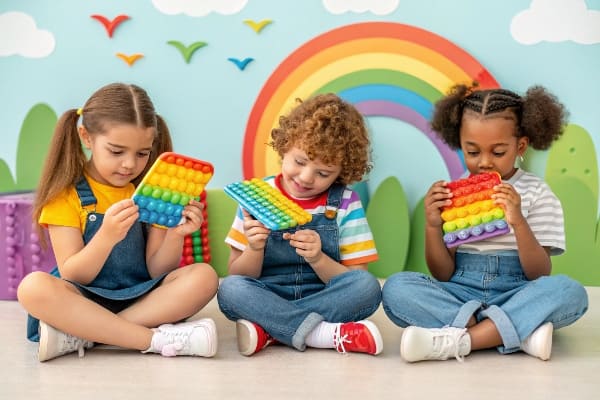
Why people buy and how I display
A Pop It gives simple sensory feedback8. The bubbles click and reset. This helps users manage stress and attention. Parents buy them as small treats. Teachers buy them in packs. I place Pop Its on countertop or clip-strip displays close to the line. I use bright but clean graphics so the product stays the hero. I design small trays that hold color mixes and avoid mess. I print clear price tags so the decision is fast. I use recyclable board and water-based inks because many buyers value eco choices9. When supply changes, I swap trays without reprinting full units. I keep SKUs tight to avoid choice overload.
Assortment and message flow
| User Need | Why Pop It Helps | Best Placement | KPI I Track |
|---|---|---|---|
| Calm & focus10 | Repetitive tactile cue | Countertop near POS | Units per thousand |
| Small reward11 | Low price, bright look | Front bins, endcaps | Basket attach rate |
| Classroom use | Bulk packs, labels | Aisle clip strips | Sell-through by pack |
| Gift add-on | Seasonal colors/cards | Seasonal table | Markdown avoidance |
I once built a PDQ tray12 for a convenience chain. The store had tiny counters. I used a narrow 1/8 pallet and two clip strips beside gum. The buyer saw a clear attach to energy drinks and candy. We printed QR codes13 for "quiet game ideas." The unit shipped flat, set up in two minutes, and lifted attach rate14 in week one. The store kept reordering because the design made refills simple.
What is the advantage of pop display?
Most ads talk far from the product. POP meets the buyer at the shelf. I use POP to turn brand intent into real choices where the hand reaches the item.
The advantage of a POP display is faster conversion at lower cost: it wins attention, explains value in seconds, guides trial, and scales with flexible, recyclable materials and quick-turn digital printing.
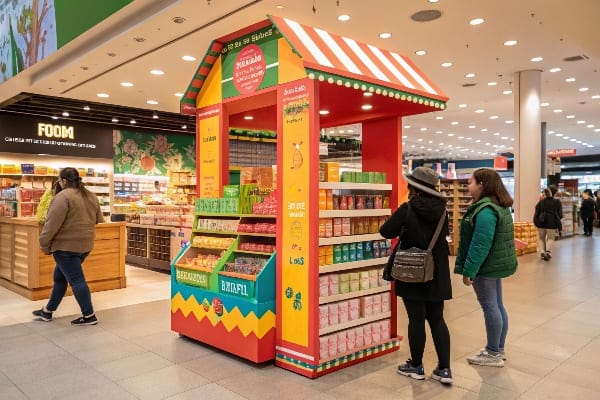
Marketing, operations, and sustainability15 in one
POP blends marketing and logistics. On the marketing side, floor displays16 often carry the most visual weight. Industry tracking I use shows floor formats hold a large share of POP usage, and they keep growing because impact is direct. On operations, corrugated units ship flat and assemble fast, so brands hit seasonal windows. On sustainability, recycled fibers and water-based inks lower footprint and support retailer goals. I build for strength with single-wall where fit, and reinforce key joints. I test load and transport before mass run. I use digital print for short runs and variable art, which helps regional tests. I keep designs modular, so a header swap moves the same body between promotions.
| Advantage | What It Means In Store | Proof I Look For | Action I Take |
|---|---|---|---|
| Attention | Stand-alone structure, bold header | Dwell time, eye tracking | 3-second rule layout |
| Speed to market | Flat-pack, tool-less locks | Setup time, compliance photo | Add QR setup guide |
| Cost effectiveness17 | Lower material, fast print | Cost per unit vs lift | Right-size board, avoid overbuild |
| Flexibility | Sizes and shapes for any SKU | SKU fit rate | Modular trays, adjustable shelves |
| Sustainability18 | Recyclable, recycled content | Retailer acceptance | FSC materials, water-based inks |
In peak season, my team once moved a national beverage brand from metal to cardboard19. We cut freight and setup time. We kept impact with a tall header and angled shelves. Sell-through rose because stockers could refill faster, and graphics showed flavors clearly.
What is the point of purchase pop display?
A point-of-purchase display sits where the decision happens. I place it on the floor, pallet, shelf, or counter. The goal is simple: prompt action with zero confusion.
A point-of-purchase POP display is a temporary or semi-permanent unit placed at the buying zone that focuses attention, answers the last question, and nudges immediate selection or add-on.
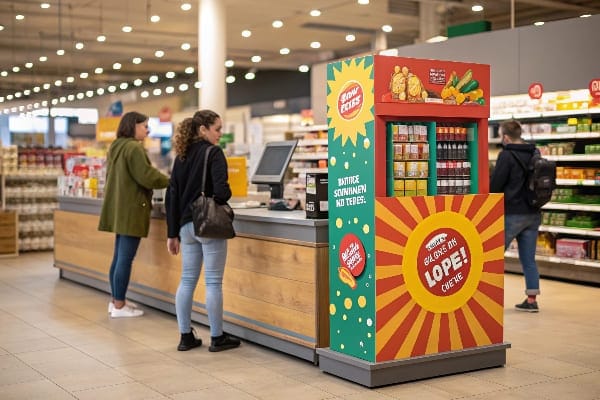
Core elements that drive action
A good POP unit has four elements. First, a strong headline that says the benefit in plain words. Second, a clear price or bundle. Third, a product planogram20 that avoids gaps and mixed facings. Fourth, simple brand cues that fit the retailer. I build the body in corrugated board so it ships flat and stands solid. I use tabs and slots so staff can assemble without tools. I print color bars to match SKUs. I add a small callout for QR or NFC21 if the brand wants an online tie-in.
Execution roadmap I follow
I start with a store walk. I note shopper flow22, lighting, and obstacles. I pick a footprint that fits traffic and safety. I design shelves to the product's real weight, not the brochure weight. I run a transport test, a tilt test, and a quick assembly test. I make a one-page setup guide with photos. I create a compliance checklist23 so the team can send a fast proof photo. If stock is heavy, I add a pallet base. If stock is light, I add spacers so the top always looks full. I track sell-through by week and refresh headers to keep signs current.
A short case from a hunting launch
I supported a U.S. hunting brand on a tight new-season timeline. The product was a compact bow24 with many accessories. The buyer needed fast setup in outdoor chains and farm stores. I built a floor unit with lockable hooks for the heavy SKUs25 and small trays for wax and small tools. The header read "Ready to Hunt in Minutes." A side panel showed a three-step mount photo set. We hit the date because the structure used repeatable parts and digital print. The client launched on time and avoided markdowns because the unit kept accessories together and lifted the average basket.
| Element | Purpose at POP | My Rule of Thumb | Common Mistake |
|---|---|---|---|
| Header | State benefit in 3 sec | Seven words or fewer | Clever but vague slogans |
| Price block26 | Remove friction | One price, big and honest | Tiny tags and hidden bundles |
| Product layout27 | Guide hands | Heavy low, light high | Mixed facings, empty fronts |
| Structure strength | Keep it safe | Test to 1.5× load | Overtrusting sample strength |
Conclusion
A clear purpose drives every POP choice: stop, show, and sell at the shelf with simple design, fast setup, and honest benefits that help real shoppers decide now.
Learn how day-part content can optimize your advertising efforts by targeting specific times of the day. ↩
Understanding the concept of a moving benefit shot can enhance your content strategy, making it more engaging and effective. ↩
Exploring the benefits of flat-pack parts can help streamline your shipping process and improve assembly efficiency. ↩
Explore this link to understand how effective clips can minimize returns by ensuring customers choose the right products. ↩
Discover proven strategies that can enhance your conversion rates by effectively showcasing proof and pricing next to products. ↩
Explore how a 7-inch screen can enhance customer engagement and boost sales in retail environments. ↩
Learn effective strategies to increase conversion rates significantly, driving more sales and revenue. ↩
Understanding sensory feedback can enhance your knowledge of stress management techniques and improve your well-being. ↩
Exploring the significance of eco choices can help you make informed purchasing decisions that benefit the environment. ↩
Explore this link to understand how tactile cues can enhance focus and calmness, benefiting various environments. ↩
Discover effective retail strategies for using small rewards to boost customer engagement and sales. ↩
Explore this link to understand the design and benefits of PDQ trays in boosting sales and efficiency in retail. ↩
Discover innovative ways to leverage QR codes in retail to enhance customer engagement and drive sales. ↩
Understanding attach rate is crucial for boosting sales; explore this link to learn effective strategies for increasing it. ↩
Discover the importance of sustainability in modern business practices and how it can improve brand reputation and customer loyalty. ↩
Explore how floor displays can enhance visibility and sales, making them a crucial element in effective marketing strategies. ↩
Understanding cost effectiveness can help you optimize your packaging strategy and reduce expenses. ↩
Exploring sustainability in packaging can enhance your brand's image and appeal to eco-conscious consumers. ↩
Explore this link to understand how cardboard packaging can enhance sustainability and efficiency in beverage distribution. ↩
Understanding product planograms can enhance your retail strategy, optimizing product placement for better sales. ↩
Exploring QR and NFC technologies can help you leverage digital interactions to boost customer engagement and sales. ↩
Understanding shopper flow is crucial for enhancing customer experience and increasing sales. Explore this link for expert insights. ↩
A well-structured compliance checklist ensures operational efficiency and safety. Discover best practices to implement one effectively. ↩
Explore this link to understand why compact bows are ideal for hunters seeking portability and efficiency. ↩
This resource offers insights on displaying heavy SKUs, enhancing visibility and sales in your store. ↩
Understanding the role of a price block can help you create more effective marketing strategies that reduce friction for customers. ↩
Exploring product layout strategies can enhance your ability to guide customer decisions and improve sales. ↩
